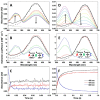The Catalytic Cycle of the Antioxidant and Cancer-Associated Human NQO1 Enzyme: Hydride Transfer, Conformational Dynamics and Functional Cooperativity
- PMID: 32825392
- PMCID: PMC7554937
- DOI: 10.3390/antiox9090772
The Catalytic Cycle of the Antioxidant and Cancer-Associated Human NQO1 Enzyme: Hydride Transfer, Conformational Dynamics and Functional Cooperativity
Abstract
Human NQO1 [NAD(H):quinone oxidoreductase 1] is a multi-functional and stress-inducible dimeric protein involved in the antioxidant defense, the activation of cancer prodrugs and the stabilization of oncosuppressors. Despite its roles in human diseases, such as cancer and neurological disorders, a detailed characterization of its enzymatic cycle is still lacking. In this work, we provide a comprehensive analysis of the NQO1 catalytic cycle using rapid mixing techniques, including multiwavelength and spectral deconvolution studies, kinetic modeling and temperature-dependent kinetic isotope effects (KIEs). Our results systematically support the existence of two pathways for hydride transfer throughout the NQO1 catalytic cycle, likely reflecting that the two active sites in the dimer catalyze two-electron reduction with different rates, consistent with the cooperative binding of inhibitors such as dicoumarol. This negative cooperativity in NQO1 redox activity represents a sort of half-of-sites activity. Analysis of KIEs and their temperature dependence also show significantly different contributions from quantum tunneling, structural dynamics and reorganizations to catalysis at the two active sites. Our work will improve our understanding of the effects of cancer-associated single amino acid variants and post-translational modifications in this protein of high relevance in cancer progression and treatment.
Keywords: antioxidant enzyme; antioxidant response; cancer; conformational dynamics; enzyme kinetic analysis; functional cooperativity; hydride transfer; kinetic isotope effects; oxidoreductase; quantum tunneling.
Conflict of interest statement
The authors declare no conflict of interest. The funders had no role in the design of the study; in the collection, analyses, or interpretation of data; in the writing of the manuscript, or in the decision to publish the results.
Figures










References
-
- Ross D., Siegel D. NQO1 in protection against oxidative stress. Curr. Opin. Toxicol. 2018;7:67–72. doi: 10.1016/j.cotox.2017.10.005. - DOI
Grants and funding
- RTI2018-096246-B-I00/ERDF/Spanish Ministry of Science, Innovation and Universities-State Research Agency
- (Grant PID2019-103901GB-I00/Spanish Ministry of Science and Innovation-State Research Agency
- P11-CTS-07187 and P18-RT-2413/Consejería de Economía, Conocimiento, Empresas y Universidad, Junta de Andalucía (Grants, to A.L.P.)
- Grant E35_20R/Gobierno de Aragon-FEDER
LinkOut - more resources
Full Text Sources
Other Literature Sources
Miscellaneous

